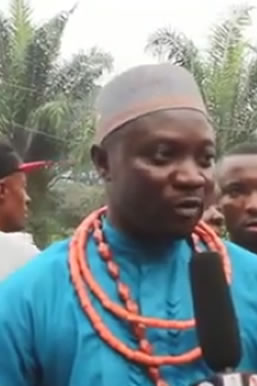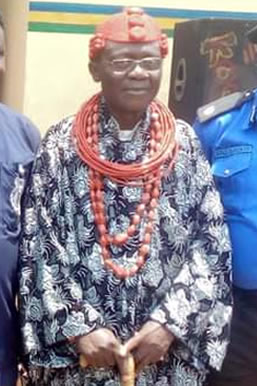The correct name is EBHOSA.

H.R.H Usiho Onojie Of Ewossa
Despite the evil of modern mercenary politics, the blood tie between Ewohimi and Ewossa has survived the years. It is an unkind distortion of history for honest looking men in both Ewossa and Ewatto to say that this blood tie originated from Benin and that the founders of Ewohimi, Ewossa and Ewatto arrived Esan, men of equal calibre. It is one thing to claim and insist on absolute independence and quite another thing to use arguments not only baseless but calculated to wreck some of our beautiful traditions and rites.
The facts are that while the founder of Orikimi, IKIMI arrived Esan country about 1460, the founders of EHBOSA and EBHOATO were of IKIMI'S THIRD GENERATION - that is both were Ikimi's great grandchildren. Osa was the second son, after the banishment of Ibi, of Onojie Osoah of Orikimi. Between 1500 and 1504, when Prince Aruaruan was making his gigantic strength felt all around Benin, settlements on the Esan side of River Ossiomo could never tell how many of their members would be kidnapped the next day. No one could really talk who was a genuine Benin trader and who was an Aruaruan eye in the jungle, since traders, spies and slave raiders approached this part of Esan via the Ossiomo route. To guard the Benin approaches to Orikimi, a group of Ekakulo were stationed somewhere in the jungle. At the head of the men was Prince Osa. He with his warriors founded Ebhosa. By the time Osoah, Osa's father died about 1520, Osa's settlement was already growing.
When Agaah, his senior brother succeeded their father, both the inhabitants of Ebhosa and Ebhoato considered themselves members of Orikimi just as men in cottages consider themselves members of the village of their origin. The actual onset of bitterness was when Agaah died and Osawe became Onojie round about 1540 when Esigie was Oba of Benin. A new King who did not realise that the people of Ebhosa were his own kith and kin, was the real trigger that started the Ewohimi - Ewossa feud. Osawe was in the habit of thinking of both Ebhosa and Ebhoato as outlying villages
- IGULE of Ewohimi. With that state of mind, his people got into the offensive habit of seizing men from either place whenever a head was urgently required at Eguare Orikimi.
Ebhosa and Ebhoato retaliated as much as their inferior member would allow, but they began to think of themselves as distinct people from Orikimi and began to assert that thought - their insistence on having their own Onojie became so disturbing that Osawe had to install Osa, Onojie Ebhosa; that was round about 1545, five years after Osawe's accession (the Orikimi throne. Later Ato's heir Oloon was made Onojie of Ebhoan some five years later. This only eased matters in as much as at the end the traditional year, people of the two places came down to Orikimi for the worship of their great father OSOAH who was deified. Traditionally all free born of Orikimi, Ebhosa and Ebhoato were strictly forbidden the sight one another's blood, but with the inherent superiority of Orikimi and the irresistible urge to dominate the weaker settlements, skirmishes were no infrequent and the men offending the spirit of Osoah justified their action be the consoling thought of provocation.
With growth in number came pride and increasing insubordination Although Ebhosa had for long considered itself no longer a part of Orikimi the perennial worship of Osoah at Eguare Orikimi and the going to Orikimi for the installation of a new Ebhosa Onojie, was not just admittance inferiority but was the essential spirit of idiocy for a man claiming to be the constitutional head of an independent state. Thus when the great wealth) Ogbole became Onojie of Ebhosa in 1820, he decided to find a master no just higher than himself but certainly towering above the Onojie of Orikimi That only person was the Oba of Benin: Ogbole had one big advantage Osemwede, who only four years previously, that is around 1812, was, hibernating prince in Esan land, had become Oba of Benin and was eve) ready to show his gratitude to any accredited leader from Esan. But (found himself in a most embarrassing position from which he could only wriggle out by virtue of his awe-inspiring station in life. Here was a leader, Ogbole, an undisputed head of a district that gave him implicit loyalty where he was so ably protected by the great Odia of Orikimi; but this same man was doing something to throw dust in the face of his protector - Odia! If he installed Ogbole Onojie, he would be offending Odia, and if he refused to do so, Ogbole who served him so well, would be thoroughly disgraced Well he was now OBA, the lord supreme of all Enijie anyway; further then were large gains topped with a human head, one slave . So Oba Osemwede accepted the necessary tributes from Ogbole, installed him Onojie and he was given the Ada or state sword, round about 1820. That practically brought Ebhosa to the same sovereign level as Orikimi and the only difference being that one was large and the other small. This was the state of affairs until the advent of the British in 1900. In 1903 when the Native Court was established at Uromi, Izebhijie of Ebhosa attended the Court as a full sovereign just as did Ifehbo of Ebhoikimi. Then circumstance brought Ebhosa once again under the heels of Ebhoikimi: in 1918 a Native Court was established in Ebhoikimi, thus making it the judicial headquarters for all Ishan 'B'. It was history repeating itself! Neither the reorganization of 1934 nor the Mccall Constitution of 1950 could win back for Ebhosa all Ogbole had achieved in 1820. Back again went Ehbosa and Ehboato – tied to the political apron-string of EBHOIKIMI.
Ewossa consists of six villages:-
1. EGUARE:
This is the ramification of Osa's original settlement and itself consists of Uhaekpen, Idumuaghaeyen and Olenokhua.
2. UJIELU:
This place was founded by Oza who led the party of immigrants from Egoro. He was made the first Oniha. He was later joined by a Benin man called Ogbe, the founder of Idumogbe. Ikekiyala is an extension of these two quarters on the other side of the moat.
3. IDUMU - IYASELE:
This is the over-all name for Idumagbo (434-1614), where the Iyasele of Ewossa lives, Idumobo (607), Idunegbon (394) and IdumuIgibhewa. The Idumagbo-Idunegbon area was founded by Owerain, a warrior and a blacksmith from Agbor. Idumu-Obo was founded by Ihienhien, a renowned native doctor from Ebhoato.
4. IDUMEGHA:
This place was founded in the main by immigrants from Uromi.
5. lKEKOGBE:
This is the group name for Idumekhae, Odugha and Omen; as usual Ikekogbe was the place where the Onojie's servants and slaves used to live and is just behind the palace in most Esan Eguare and hence it forms an extension of the capital village.
6. IDUMUOGO:
Customarily some farms houses develop into villages when to farmers cease to return home to the village hence Idumogo is a frequency name in all districts of Esan. The farmer who founded this particular came from Eguare.
II KINGMAKERS:
Two quarters of Eguare - Uhaekpen with Idumuaghaeyen and Olenokhua constitute the kingmaker's quarters in Ewossa. In 1986 to Osukhure was Iregbeyanje who as usual was from Uhaekpen.
III INSTALLATION:
In recent times, the habit of Ewossa is for the Oniha to arrive Eguare to install the heir, five days after the death of the last Onojie. There he must begin the burial ceremonies at once, for should he die before he completes them his children forfeit the claim to the title. This departure from Esan custom was an attempt to off-set succession strife are to quicken completion of all essential ceremonies that would make the needed man the lawful Onojie. The consequences of failure to complete the ceremonies are no less disastrous.
V. COMMENTS:
(a) OGBOLE (1820 - 1850): Was the first Onojie to make the real bid for freedom from Ewohimi. He was installed Onojie by Oba Osemwede about four years after he himself left Esan. He returned home the possessor of the coveted Ada - "same as the Onojie of Ewohimi!"
(b) ODIA (1850 - 1870): He was the ruler of Ewossa during the Amahor War. Ewossa like Ewohimi and Okalo remained faithful to Oba Adolo during these risings.
(e) IZEBHUIE (1870 - 1939): He had many things to his advantage. He became Onojie as a young man of about 18, and full of youth he had one aim - to make Ewossa independent in everything and owing, allegiance only to the Oba. Fortune gave him a very important friend is 1898. During the Benin Expedition of 1897 Prince Aiguobasimwi took refuge at Urhonigbe in Benin. When enemies, mostly Chiefs, who wanted to get him out of the way so that they could usurp the privileges that went the Oba's , kept lying against him that he was preparing to return battle with the Whiteman, Aiguobasimwi wisely decided to leave Benin with its intrigue and greedy Chiefs seeking favour from the British. On his way to his mother's home at Okuta Ebelle, he got to Ewossa where he passed the night with Chief Uwadia. Next day a man called Atakpo led him to Ebelle when he was taken to his mother's village. He very simply narrated his misfortunes at Benin and expressed his desire to live in private and it peace. Okuta, like Ebelle, thought that with the Whiteman now firmly established in Benin, the OBA'S WORLD was gone and so they though there was very little likelihood of Aiguobasimwi ever returning to Benin City. With this in mind some of them thought that if he stayed he might (dominate them as to enslave them. Unbelievably, they announced then regret and showed the unhappy Prince the door. Mortified the Prince returned to Ebhosa where he had been shown so much kindness the night before. He was given a comfortable place to live in at Uwadia's house. He lived here for about one year, and here he had a daughter named UBHINESAN. During this humiliating period in exile, the experience Izebhijie, gave the Prince the service of an overlord, and in 1914 wheel Aiguobasimwi became Oba Eweke II, he sent for the Onojie who Wall accompained by Atakpo and Oijade. He loaded him with presents and issued him with a second Ada.

Late.Eidenogie I Onojie Of Ewossa
Izebhijie's contemporaries were Eromosele of Irrua, Imadojiemun of Opoji etc.
VI. IMMEDIATE PAST ONOJlE: ·
Ogbeide II became the Onojie at the age of 42, in 1947, after the short reign of his father Oboboiki. He died on May 6, 1981.
Eidenojie who as a Prince was known as Stephen Eidenojie Ogbeide. He attended Ewohimi Grammar School and Esigie Teacher Training College, Abudu from 1969 to 1973. He taught as a Grade II Teacher in Ekpon and Ebelle, returning home on the death of his father on May 6, 1981. He performed the burial ceremonies of his father and ascended the throne of Ewossa getting approval from the Bendel Government on 21st May, 1981.
VII NON-AGRESSION PACT:
There was a natural understanding between the people of Ebhosa and Ewohimi and also Ewatto, due to their blood relationship - but during the bitter struggle for independence, blood was freely spilled to the horror of their ancestors! There were several wars with Ekpon and Ebelle.